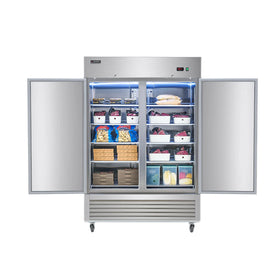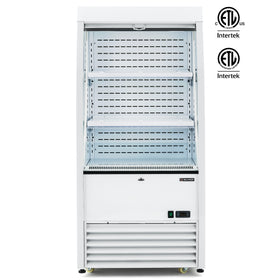Setting up any kind of food business is all about getting certain “behind-the-scenes” decisions right, and one of the most important decisions you’ll make is to get the right commercial refrigerator.
Three things matter the most when choosing a fridge for a cafeteria:
- First, you want a unit that is top-quality and capable of keeping food items at optimal temperatures.
- Second, it also needs to be the right size and fit. A cafeteria fridge becomes the backbone for food safety, storage efficiency, and overall workflow in the cafeteria, especially if you are using it in the back kitchen.
- Third, you need to figure out if one fridge will suffice for the needs of your cafeteria, or if you need a combination of different types of refrigerators to cover different refrigeration needs.
Here are 9 important points to help you select the best fridge for your cafeteria. We are also adding some real-world details and some examples to make your choice clearer.

1. It Must Match the Capacity and Size of Your Cafeteria
Capacity is the first factor to think about when choosing a fridge for a cafeteria: you must choose a refrigerator with enough capacity to match the amount of food you intend to store.
Depending on storage demands, you also have to consider the possibility that you might need more than one refrigerator. Bigger cafeterias need bigger (or more refrigerators), and vice versa.
Cafeteria Fridge Size Recommendations
| Cafeteria Size | Meals/Day | Recommended Refrigeration |
| Small | Up to 100 | A couple of reach-in refrigerators (40–60 cu. ft. each) |
| Medium | 100-300 | Walk-in cooler (80–100 sq. ft.) + 2–3 reach-in refrigerators for daily prep |
| Large | 300+ | Full-sized walk-in cooler + multiple reach-ins or prep table fridges |
Cafeteria Fridge Space Considerations
When choosing a refrigerator for cafeteria, don’t just measure your storage needs: measure the space available too.
Cafeteria kitchens tend to be very tight, so be sure to account for door swing clearance, leave some space for airflow around the unit, and easy access during service hours.
2. Choose the Right Type(s) of Cafeteria Refrigerators
As a rule, cafeterias need commercial refrigerators. However, different cafeteria setups call for different types of commercial refrigerators. Many times, the best solution to cover all the refrigeration needs of a cafeteria is a combination of different types of commercial refrigerators.

Best Refrigerator Options for a Cafe
1. Reach-in refrigerators
Commercial reach-in refrigerators will be great in a cafeteria for storing ready-to-use ingredients. A larger reach-in refrigerator like this 3-door reach-in refrigerator with a durable stainless steel construction and 61 cu.ft capacity would be ideal. But you can go for a smaller-sized model for dairy, sauces, and chopped produce.
2. Walk-in coolers
If you buy in bulk, and your cafeteria is large enough to require a storage area, you have to consider a walk-in cooler. Think of this as your “warehouse” for perishable items. Walk-in coolers are great for milk crates, cases of produce, and large cuts of meat.
3. Undercounter or prep table fridges
An undercounter or prep table fridge helps efficiency in cooking as well as storage in a cafeteria. The best models, like this 61" 2 Door Commercial Prep Table, come with a cutting board top for sandwich, salad, or pizza prep stations. Consider a refrigerated prep table with multiple ingredient pans for quick assembly lines.
4. Display refrigerators
If your cafeteria has a self-serve section, you absolutely need a commercial display refrigerator. It is specially designed with glass doors for storing and displaying bottled drinks, yogurt cups, or packaged salads, so customers can easily see and grab them.
Consider a display refrigerator with glass doors: this 21.2" Commercial Merchandiser Refrigerator comes with 8.6 cu. ft. capacity, which is perfect for placing near the checkout line.
3. Temperature Control and Consistency
Food safety is non-negotiable in a cafeteria: a refrigerator for cafeteria must be capable of keeping the food within safe temperature limits. Commercial units should hold temperatures between 34°F and 40°F (1°C–4°C).
Here’s what to look for:
- Digital temperature displays for easy reading
- Alarms or auto-locking doors that alert you when temperatures rise above safe levels.
- Fan-forced cooling for even temperature distribution, especially if you’re storing dense trays of food.
For added peace of mind, you might want to consider some of the modern models that come with remote monitoring that lets you check temperatures from your phone.
4. It Must Be Energy Efficient
Cafeteria fridges run all day, every day, so the best fridge for a cafeteria must be able to minimize energy usage without compromising food safety. For your cafeteria fridge, look for the following:
- Energy Star Rating: Energy Star-rated fridges typically use 20–30% less energy than non-rated models.
- LED lighting: it reduces heat inside the fridge while cutting electricity use.
- A high-efficiency compressor and eco-friendly refrigerants to help save money and reduce environmental impact.
Over 10 years, an energy-efficient commercial fridge can save thousands of dollars in utility costs, sometimes more than the fridge cost itself.
5. Check For Durability and Build Quality
For a cafeteria fridge, you want a unit that is durable, solid, and high-quality. Look for the following features:
- Stainless steel material (both interiors and exteriors)
- Heavy-duty door gaskets to keep cold air in
- Self-closing doors with stay-open features to prevent wasted energy when busy.
- Adjustable heavy-gauge shelving, strong enough to hold heavy pans and crates without bowing.
- Casters (locking wheels) to make it easier to roll the fridge out for cleaning and maintenance.
Remember that cafeteria fridges are not usually treated very gently: the doors get slammed, shelves get overloaded, and staff are constantly in and out during rushes. Signs of durability include:
Pro tip
Ask about the warranty. A good commercial fridge should come with at least a 2-3 year warranty on parts and labor, and 5 years on the compressor.
6. Ensure It Is Easy to Clean and Maintain
Cafeteria kitchens move fast, and cleaning has to be efficient. Look for features like:
- Removable, adjustable shelves for quick wipe-downs.
- Rounded interior corners that don’t trap food debris.
- Front-access condenser coils so technicians can clean and service without tearing your kitchen apart.
Maintenance is just as important-choose a brand with parts and service available locally. The last thing you want is to wait weeks for a replacement fan motor while your walk-in cooler sits idle.
Discover how to clean and service a commercial refrigerator.
7. Compliance and Safety Requirements
Most cafeterias are inspected regularly, so make sure your refrigerator meets NSF (National Sanitation Foundation) standards or equivalent certifications in your area.
Health departments may also require built-in thermometers or logging systems to prove food was kept at safe temperatures. Choosing a fridge that already meets these requirements saves headaches later.
8. Workflow and Accessibility: Keep the Kitchen Moving
A cafeteria kitchen is like a dance floor-everyone has to move quickly without bumping into each other. Your fridge choice plays into that:
- Swing vs. sliding doors: Sliding doors are great for narrow kitchens where swinging doors might block walkways.
- Split doors (half-height): Reduce cold air loss since you only open part of the fridge at a time.
- Glass doors: Speed up item retrieval (no more opening five doors to find the ketchup).
Think about how often items will be accessed-bulk storage belongs in the walk-in, while high-turnover items should be in easy reach of cooks and servers.
Final Thoughts
The “best” cafeteria refrigerator isn’t a single model-it’s the right combination of storage, durability, and efficiency tailored to your operation. For most cafeterias, that means a walk-in cooler for bulk storage paired with reach-ins or prep fridges near cooking stations, plus a display fridge if you offer grab-and-go items.
Plan carefully, and your refrigerator will not only keep your food safe but also streamline your workflow, save energy, and support your cafeteria for years to come.
Explore some unexpected 10 ways restaurants make money that may work for your cafe.













